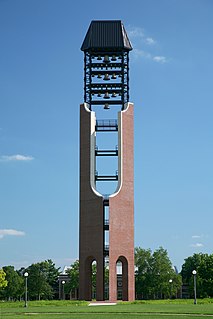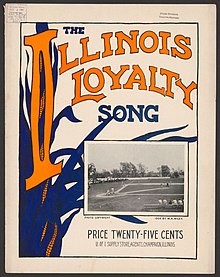In several countries’ sports, a fight song is a song associated with a team. In both professional and amateur sports, fight songs are a popular way for fans to cheer for their team. In addition, they are often laden with history; in singing a fight song, fans feel part of a large, time-honored tradition. Although the term "fight song" is primarily used in the United States and Canada the use of fight songs is commonplace around the world, but they may also be referred to as team anthems, team songs or games songs in other countries, including Australia, Mexico and New Zealand. Fight songs differ from stadium anthems, used for similar purposes, in that they are usually written specifically for the purposes of the team, whereas stadium anthems are not. In Australian Rules Football it is tradition for the song to be sung by the winning team at the end of the game.

The Cornell Chimes is a 21-bell chime in McGraw Tower on the central campus of Cornell University, in Ithaca, New York, United States.

The Illinois Fighting Illini are the intercollegiate athletic teams that represent the University of Illinois Urbana-Champaign. The university offers 10 men's and 11 women's varsity sports.

"Far Above Cayuga's Waters" is Cornell University's alma mater. The lyrics were written circa 1870 by roommates Archibald Croswell Weeks, and Wilmot Moses Smith, and set to the tune of "Annie Lisle", a popular 1857 ballad by H. S. Thompson about a heroine dying of tuberculosis.

The Marching Illini (MI) is the marching band of the University of Illinois Urbana-Champaign. The Marching Illini is an organization which annually includes approximately 400 students enrolled in the University of Illinois. Part of the College of Fine and Applied Arts and Illini Athletics, the Marching Illini represent virtually every college, discipline, and major on the University's diverse Urbana-Champaign campus.
The Cal Poly Mustang Band, also known as The Pride of the Pacific, is the official marching band of California Polytechnic State University in the city of San Luis Obispo, California. Although the band is not a competitive marching band they serve as a school spirit organization. The band functions in two different forms throughout the year. In the fall the band marches as The Mustang Marching Band and during Cal Poly's winter quarter they function as a pep band. The band attends many athletic events during the year to encourage the school's athletic teams and audience support/involvement. The marching band is well-known around campus as an exciting and spirited group that brings pep, passion, and tradition to every performance. The marching band is conducted by three directors: Christopher J. Woodruff, Nicholas P. Waldron, and Len Kawamoto.
Oskee Wow-Wow is the official fight song of the University of Illinois at Urbana-Champaign. The song was written in 1910 by two students: Harold Vater Hill '11 (1889–1917), credited with the music, and Howard Ruggles Green '12 (1890–1969), credited with the lyrics.
The "Go U Northwestern", originally titled "Go Northwestern Go", is one of the fight songs of Northwestern University.

The "Penn State Alma Mater" is the official alma mater of The Pennsylvania State University. The song was accepted by the university in 1901.

Albert Austin Harding was the first Director of Bands at the University of Illinois and the first band director at an American university to hold a position of full professorship. The Harding Band Building, the first dedicated building for a University Band Department, was named for him.

The Alma Mater, a bronze statue by sculptor Lorado Taft, is a beloved symbol of the University of Illinois Urbana-Champaign. The 10,000-pound statue depicts a mother-figure wearing academic robes and flanked by two attendant figures representing "Learning" and "Labor", after the University's motto "Learning and Labor." Sited at the corner of Green and Wright Streets at the heart of the campus, the statue is an iconic figure for the university and a popular backdrop for student graduation photos. It is appreciated for its romantic, heraldic overtones and warmth of pose. The statue was removed from its site at the entrance to the university for restoration in 2012 and was returned to its site in the spring of 2014.

"Hail to Pitt" is the most traditional fight song of the University of Pittsburgh, which is commonly referred to as Pitt. The saying "Hail to Pitt!" is also the most traditional and commonly used slogan of the University of Pittsburgh and its athletics teams. The slogan is frequently used in promotional material, printed on merchandise and souvenirs. It was also the title of a 1982 history of Pitt athletics by author Jim O'Brien. The slogan is often used among alumni as a statement of affiliation, including as a closing signature in conversation or correspondence between alumni, and is sometime abbreviated as "HTP" or "H2P", the latter of which is a registered trademark of the university and is frequently used on official university signage and merchandise.

Altgeld Hall, located at 1409 West Green Street in Urbana, Illinois on the University of Illinois Urbana-Champaign (UIUC) campus, was built in 1896–97 and was designed by Nathan Ricker and James M. White of the University's architecture department in the Richardsonian Romanesque style. Planning for the building began during the Illinois governorship of John Peter Altgeld. The building was originally the University Library, and received major additions in 1914, 1919, 1926, and 1956. From 1927 to 1955 it was used by the College of Law, and from 1955 on by the Department of Mathematics and the Mathematics Library. The University Chime in the bell tower – which marks the hours, half hours, and quarter hours and plays a ten-minute concert every school day from 12:50–1:00 p.m. – was installed in 1920. The building was officially named "Altgeld Hall" in 1941.

The Pride of the South is the name of the marching band at The University of Mississippi in Oxford, Mississippi. The full band plays at all Ole Miss home football games, and a smaller pep band is sent to most away games. The full band also travels to Ole Miss bowl games and Starkville, Mississippi when Mississippi State University hosts the Egg Bowl. The University of Mississippi Band has been giving outstanding performances in concert and in support of Ole Miss athletic events since it was organized in 1924. In addition to performing at all home football games and many away games, the marching band has attended numerous bowl games including the Sugar Bowl, the Gator Bowl, the Liberty Bowl, the Independence Bowl, the Peach Bowl, the Cotton Bowl, and more recently the Motor City Bowl in 1997, the Music City Bowl in 2000, the Independence Bowl in 1998, 1999 and 2002, the Cotton Bowl in 2004, 2009 and 2010, the Chick-fil-a Classic in 2014, the Peach Bowl in 2014, the Chick-fil-a Kick Off Game in 2021, and the Sugar Bowl in 2016 and 2022.

The McFarland Carillon, sometimes referred to as the McFarland Bell Tower or McFarland Memorial Bell Tower is a 185-foot (56 m) bell tower located on the South Quad of the University of Illinois at Urbana-Champaign. The tower was approved by the University's trustees in 2005 and built in 2008-2009. It was designed by Fred Guyton of Peckham, Guyton, Albers & Viets. The carillon has 48 bells.

"Hail to the Orange" is the alma mater of the University of Illinois at Urbana–Champaign. Its alternate version, "Hail to the Purple," is an official song of the fraternity Sigma Alpha Epsilon. The song was written in 1910 by two students: Harold Vater Hill, credited with the music, and Howard Ruggles Green, credited with the lyrics.

The history of the University of Illinois Urbana-Champaign dates back to 1862. U of I is a public research-intensive university in the U.S. state of Illinois. A land-grant university, it is the flagship campus of the University of Illinois system. The University of Illinois Urbana-Champaign opened on March 2, 1868, and is the second oldest public university in the state, and is a founding member of the Big Ten Conference.

The Senior Memorial Chime, known more commonly as the Altgeld Chimes, is a 15-bell chime in Altgeld Hall Tower on the central campus of the University of Illinois Urbana-Champaign, in Urbana, Illinois, United States.














